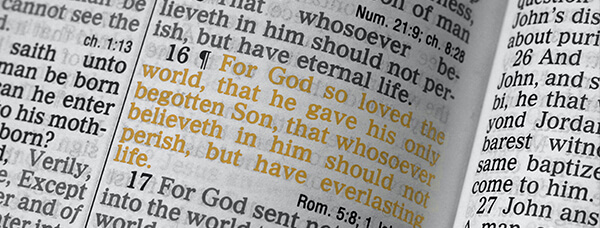In Discover Truth, by Biblica staff, November 6, 2018
“For God so loved the world that He gave His one and only Son, that whoever believes in Him shall not perish but have eternal life.” — John 3:16 (NIV)
It’s arguably the best-known verse in the Bible. All you have to do is flash the reference “John 3:16″—just seven numbers and letters—and most people know immediately what verse you’re talking about. It doesn’t matter if they are believers or unbelievers, faithful members of a congregation or dedicated avoiders of the church. They get it.
God’s Word is made up of more than 30,000 verses, and one above any other has captured the attention of the world, earning a solid place in American pop culture and around the world.
For example, did you know that:
You can find “John 3:16” printed on the bottom rim of every drink cup at In-and-Out Burger.
World-class driver Devin Jones tours with Monster Jam and has “John 3:16” painted on the side of his monster truck, Barbarian.
Country music favorite Keith Urban included the reference in his hit song “John Cougar, John Deere, John 3:16.”
Duck Dynasty’s Si Robertson adds “John 3:15 & 17” to his signature when he signs autographs.
Charles Schultz wrote the reference into a Peanut’s comic strip.
And in 2009 Tim Tebow, then quarterback with the Florida Gators, painted “John 3:16” onto his eye black before a televised championship football game against the Oklahoma Sooners. During the game, 94 million people who saw Tim’s message googled “John 3:16.”
Why John 3:16, and How Did This Even Happen?
Many people credit the rise of John 3:16 to a man who gained notoriety in the 70’s by taking “drawing attention to yourself and getting filmed at sporting events” to a whole new level. Others note that this individual wasn’t the first to do this, but that he was the first to be caught on camera due to his odd antics (which happened during the 1977 NBA finals). Sadly, “Rainbow Man”, as he was referred to due to a frizzy rainbow wig he wore, went on to make some very poor life choices that landed him with a life sentence in prison, but that doesn’t dilute the message of the verse. In fact, it just serves as a reminder that we all need the hope found in this incredible verse.
We may never know who the first person to bring “John 3:16” on a sign to a sporting event was, but the verse was never about just one person anyway—and it was certainly never about sports at all. It was about something much MUCH bigger. That’s why it’s no surprise that, over time, it turned into a movement of fans, athletes, and celebrities, each promoting the Good News of John 3:16 in their own way. The hope found in this message, after all, was for everyone.
And yet, is the introduction of John 3:16 into pop culture the reason it’s so popular, or is it the other way around? Does the verse continue to find its way into our collective consciousness because what it promises is so powerful?
John 3:16 has been called “The Gospel in a nutshell” because it provides a stunningly succinct summary of the doctrine of the Christian faith. No wonder this verse is one of the first verses children are taught in Sunday school and backyard Bible clubs. There is perhaps no other single verse that so powerfully captures God’s heart for His creation and love for us in sending Jesus.
Over his athletic career, Tim Tebow has painted other Bible verses onto his eye black including Phil. 4:3 and Psalm 23:1. He says that, while praying over which verse to paint on his face for the championship game against the Sooners, he chose John 3:16 over any other because it’s “the essence of our Christianity. It’s the essence of our hope.”
Promoting the Good News of John 3:16
Three years to the day from publicizing this verse during the Gators/Sooners showdown, Tim, a Denver Bronco by then, played powerfully in a winning game against the Pittsburg Steelers in the playoffs.
After the game, Tim was approached by the team’s public relations representative, Patrick, who said excitedly, “Timmy, did you realize what happened?”
Tim responded, “Yeah, we just beat the Steelers. We’re going to play the Patriots.”
“No, do you realize what happened?” Patrick asked again, then said, “It’s exactly three years later from the day that you wore John 3:16 under your eyes.”
“Oh, that’s really cool.’”
“No, I don’t think you realize what happened. During the game you threw for 316 yards, your yards per completion were 31.6, your yards per rush were 3.16, the ratings for the night we’re 31.6, and the time of possession was 31.06 . . . and during the game, 91 million people Googled John 3:16 and it’s the number one trending thing on every platform.”
Perhaps, when all is said and done, if John 3:16 has found a place in pop culture and rises to the top of our collective minds now and again, it’s because that’s exactly where God wants it to be.
For God So Loved the World…
Christians have been trying to summarize the Gospel Message ever since there first was a Gospel Message. From Paul’s writings (Romans 1:16-17 comes to mind) to Christian ministries and faith-based marketing agencies of today to each one of us just sharing the good news of Jesus Christ with our friends, family, and neighbors. We’ve all at one time or another tried to explain the Gospel Message in a way that is short, concise, and impactful. And throughout history, it has all come back to one simple, yet incredibly powerful statement.
It is far more than an oversized sign at a football game or a Biblical shoutout on the bottom of a fast-food cup.
It is far more than merely a verse to memorize in Sunday school or an artsy poster to display in our homes.
It is an unending, unyielding, unchanging proclamation of the utmost form of love—a message of hope from the Spirit of the living God to the hearts and souls of His creation. It concretely sets apart our God from the many other gods of this world. It is an invitation into a relationship unlike any other we could ever experience. It is at its core the very essence of our faith—the most miraculous news the world has ever heard.
“For God so loved the world that He gave His one and only Son, that whoever believes in Him shall not perish but have eternal life.” — John 3:16 (NIV)
■
When was the last time you dwelled on this famous verse for yourself? For that matter, have you explored all that the book of John has to offer? The book was written by a man known as “the disciple whom Jesus loved” and has some fascinating distinctions that make it different from the other three Gospels. Read the intro to the book of John here, then read the full book for yourself.








